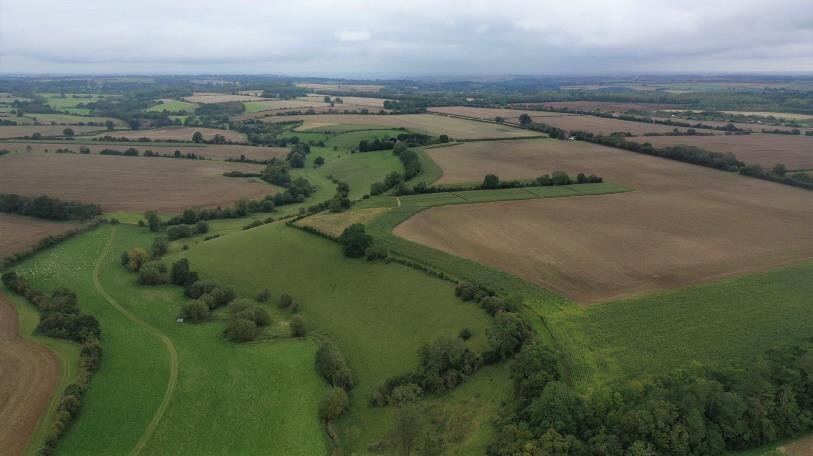Key Opportunity 4: Expanding woodlands in Cherwell

Purpose
Store carbon, protecting species by expanding and enhancing tree cover.
Description
Woodland creation is high on the political agenda in the UK – in line with recommendations by the Climate Change Committee, the national government has set a target of 30,000 hectares of new woodland creation every year by 2025.
However, identifying appropriate locations to expand woodland and hedgerow cover is vital for storing carbon in the landscape and protecting species from biodiversity decline. Equally important is sustainably managing existing woodlands.
In particular, careful site identification is crucial in order to avoid protected sites or areas of peatland or species-rich grassland.
In addition to being a carbon store, woodland and hedgerows provide crucial habitats to enhance biodiversity, providing both food and shelter. Expanding their coverage and increasing both species and structural diversity can create a ‘stepping stone’ to connect habitats. In this way, it can play an important role in restoring fragmented habitat networks.
The best woodland for biodiversity is often one with a “bit of everything” – trees of all ages from seedling to veteran, plenty of different species, damp areas, dark areas, sunny areas, grasses, brambles, spring flowers, dry banks, stony banks and mossy banks.
Why is this important for Cherwell?
As set out in the Climate Change pages, only 5.2% of Cherwell is wooded – which is well below regional and national averages. This means that a range of opportunities must be taken to increase woodland cover. This is likely to include the planting of large areas within Cherwell’s landscapes, increasing urban tree cover and increasing “riparian” tree cover as part of river corridor restoration activities.
Case studies: Oxfordshire Treescapes and Woodlands for Water
Oxfordshire Treescapes is run by GrowGreenCarbon in partnership with Oxford University’s Nature Recovery Centre. It has created the Oxfordshire Treescape Opportunity Map, a powerful tool that shows the right places to establish treescapes for the right reasons. The project has also worked with parish councils across the County to identify opportunities for nature recovery.
Dorn Valley (Image Source: Oxfordshire Treescapes)

River corridors also offer a valuable opportunity to target ‘riparian’ tree planting, which can achieve multiple GBI benefits. The Woodlands for Water project aims to improve water quality, habitat connectivity and biodiversity at selected river catchments across the UK.
To create these woodlands, farmers and landowners will be able to get advice and support from local land management advisers to apply for funding through the England Woodland Creation Offer grant. There is also a simple carbon trading offer, which provides greater financial incentives for landowners and farmers to plant and manage trees along rivers, watercourses and wider catchments.
Further guidance
- The Woodland Trust provides valuable advice on where to plant trees and how to care for them once they are in the ground. Additional documents provide advice specifically for restoring ancient woodlands.
- Key considerations for encouraging biodiversity in woodlands and hedgerows include:
- “Thinning” will produce bigger trees more quickly, help to manage the variety of tree species and let in more light to encourage woodland plants and young trees.
- Coppicing will open up temporary glades in the woodland and encourage birds, butterflies and other wildlife.
- Management needs to be carefully controlled. New track routes need to be cut where they will do the least damage.
- Old, dead and dying trees, vital for woodpeckers, beetles and other woodland wildlife need to be kept wherever possible.
- Annual flailing of hedgerows should be avoided. Where possible they should be flailed every 2 or 3 years.
Further guidance on planting and maintenance can be found in the Tree Policy for Oxfordshire.
Key delivery partners
- Oxfordshire Treescapes
- Wild Oxfordshire
- The Woodland Trust
- The RSPB
- The District and County Councils (including Property teams)
- Other major landowners – including the Forestry Commission, water companies, Church bodies, the National Trust and large estates.
- Local communities
- Town/parish councils
- Local farmers
Potential delivery mechanisms
- Shift to sustainable farming and agroforestry practices – through ELMS schemes.
- Woodland creation grants from the UK government – including the Woodland Creation Offer and its successors.
- Funding streams for carbon offsetting.
- Biodiversity Net Gain (BNG) offsets.
- Exploring opportunities for private investment in nature-based solutions (NBS).